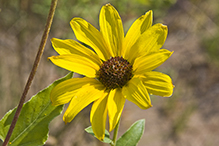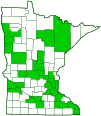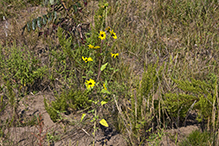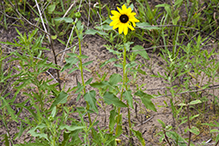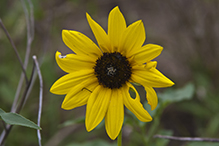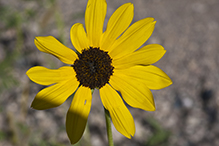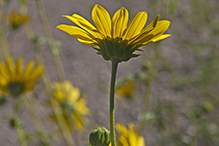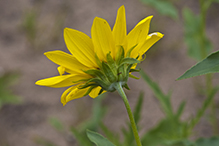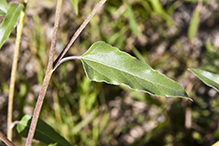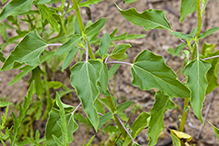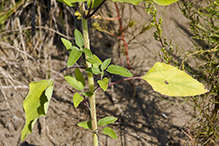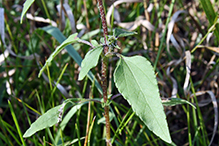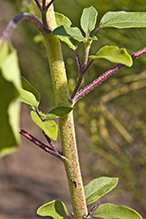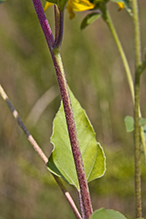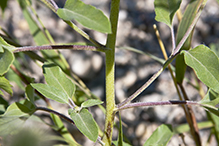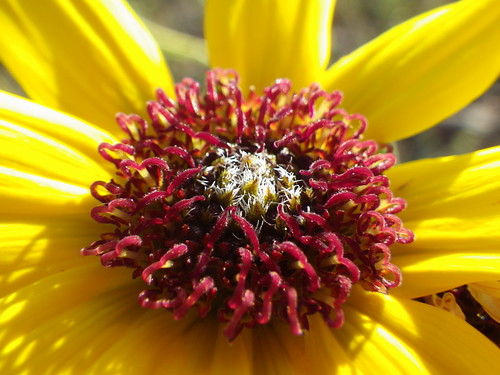prairie sunflower
(Helianthus petiolaris ssp. petiolaris)
Conservation • Description • Habitat • Ecology • Use • Distribution • Taxonomy
Conservation Status |
|
|||||||
| IUCN Red List | not listed |
|||||||
| NatureServe | N3N5 - Vulnerable to Secure SNR - Unranked |
|||||||
| Minnesota | not listed |
|||||||
Description |
||
Prairie sunflower is an erect, annual forb that rises on a single stem from a taproot. It can be from 16″ to 78″ tall, though in Minnesota it is seldom more than 40″ in height. The stems are erect, relatively stout, and moderately covered with short, stiff, ascending hairs. There are usually 8 to 25 alternate leaves. Sometimes the leaves near the base of the stem are opposite. The larger leaves are leaf stalks that are usually ¾″ to 1½″ long, but may be as much as 4″ long. The leaf blades are lance-shaped to triangular egg-shaped, and flat, not folded longitudinally. They are 2¾″ to 7″ long and ¾″ to 4″ wide, 2 to 5 times as long as wide. They are slightly heart-shaped, wedge-shaped, or squared off at the base, and taper to a sharp point at the tip. The upper surface is usually green, sometimes bluish-green, and rough to the touch with minute, straight, appressed hairs. The lower surface is similar, but may also be sparsely covered with yellow glands. The margins are untoothed or finely, irregularly toothed. The leaves have 3 main veins, a midvein and a pair of lateral veins that branch off the main vein at the base of the blade and arch upward. The inflorescence is rarely a solitary head, usually an open, branched cluster of 2 to 5 flower heads at the end of the stem. The flower heads are on stalks that are 1½″ to 6″ long or longer. The stalks usually do not have a leafy bract subtending the flower head. The whorl of bracts at the base of the flower head (involucre) is ⅜″ to 1″ in diameter. The bracts of the involucre are lance-shaped to narrowly egg-shaped and taper to a sharply-pointed tip. The tips of the bracts are sometimes loosely ascending, but more often are spreading and then curved upwards at the tip. The flower heads are 1½″ to 2½″ wide, the disk is ⅜″ to 1″ in diameter. There are 10 to 30 yellow ray florets and 50 to 100 or more reddish-brown to purple disk florets. The fruit is an achene. |
||
Height |
||
16″ to 40″ |
||
Flower Color |
||
Yellow ray florets, reddish-brown to purple disk florets |
||
Similar Species |
||
|
||
Habitat |
||
Dry. Prairies, bluff tops, railroads, roadsides, and open, disturbed areas. Full sun. Sandy soil. |
||
Ecology |
||
Flowering |
||
June to September |
||
Pests and Diseases |
||
Sunflower bullet gall midge (Pilodiplosis helianthibulla) makes ¼″ in diameter, almost globe-shaped galls on the leaves of plants in the genus Helianthus. |
||
Use |
||
|
||
Distribution |
||||
|
Sources |
|||
| 4/2/2023 | ||||
Nativity |
||||
Native |
||||
Occurrence |
||||
|
||||
Taxonomy |
|||
| Kingdom | Plantae (Plants) | ||
| Subkingdom | Pteridobiotina | ||
| Phylum | Tracheophyta (Vascular Plants) | ||
| Class | Magnoliopsida (Dicots) | ||
Order |
Asterales (Sunflowers, Bellflowers, Fanflowers, and Allies) | ||
Family |
Asteraceae (Sunflowers, Daisies, Asters, and Allies) | ||
| Subfamily | Asteroideae | ||
| Tribe | Heliantheae (Sunflowers and Allies) | ||
| Subtribe | Helianthinae | ||
| Genus | Helianthus (sunflowers) | ||
| Species | Helianthus petiolaris (prairie sunflower) | ||
Subordinate Taxa |
|||
|
|||
Synonyms |
|||
|
|||
Common Names |
|||
Kansas sunflower petioled sunflower plains sunflower prairie sunflower |
|||
Glossary
Achene
A dry, one-chambered, single-seeded seed capsule, formed from a single carpel, with the seed attached to the membranous outer layer (wall) only by the seed stalk; the wall, formed entirely from the wall of the superior ovary, does not split open at maturity, but relies on decay or predation to release the contents.
Bract
Modified leaf at the base of a flower stalk, flower cluster, or inflorescence.
Involucre
A whorl of bracts beneath or surrounding a flower, flower head, or flower cluster.


Visitor Videos |
|||
Share your video of this plant. |
|||
| This button not working for you? Simply email us at info@MinnesotaSeasons.com. Attach a video, a YouTube link, or a cloud storage link. |
|||
Other Videos |
|||

Visitor Sightings |
|||||
Report a sighting of this plant. |
|||||
| This button not working for you? Simply email us at info@MinnesotaSeasons.com. Be sure to include a location. |
|||||
|
|||||
MinnesotaSeasons.com Sightings |
|||||

|
Created: Last Updated: © MinnesotaSeasons.com. All rights reserved. |
